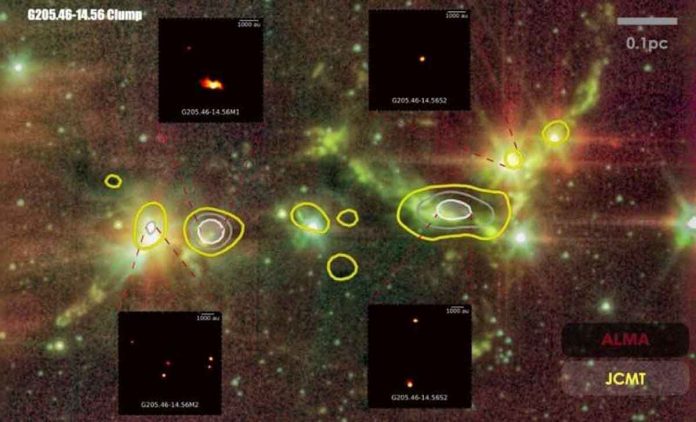Astronomers studying stellar nurseries in the Milky Way discovered that nearly half of the stars in the galaxy are formed in binary/multiple stellar systems (think twins, triplets, quadruplets).
Despite the prevalence of binary/multiple births, previous stellar nursery studies have focused on how single stars form. As a result, astronomers have long wondered about the origin of binary/multiple stellar systems.
However, an international team led by researchers from the Chinese Academy of Sciences’ Shanghai Astronomical Observatory (SHAO) has discovered that denser and more turbulent environments tend to produce multiple stars.
The Astrophysical Journal published the findings.
The gravitational collapse of cold dense pockets of gas and dust (known as cores) found in molecular clouds is required for the birth of any star. Previous research, however, has rarely addressed how the properties of these dense cores affect stellar multiplicity.
The researchers examined the Orion Cloud complex, which is the closest active star formation region to Earth, using the James Clerk Maxwell Telescope (JCMT) in Hawaii and the Atacama Large Millimetre/submillimetre Array (ALMA) in Chile. This stellar nursery, located approximately 1,500 light-years away in the Orion constellation, is an ideal laboratory for testing various models of star formation.
Using the JCMT telescope, the researchers discovered 49 cold, dense cores in the Orion clouds that are forming young stars. The researchers then used ALMA to reveal the internal structures of these dense cores.
Based on high-resolution ALMA observations, the researchers discovered that about 13 dense cores give birth to binary/multiple stars, while the remaining cores only give birth to single stars. They then used the JCMT observations to estimate the physical properties (such as size, gas density, and mass) of these dense cores.
Surprisingly, they discovered that cores forming binary/multiple stars have higher H2 gas density and mass than cores forming single stars, despite the fact that core sizes very little. “Denser cores are much easier to fragment due to self-gravity perturbations inside molecular cores,” said Luo Qiuyi, a Ph.D. student at SHAO and the study’s first author.
The team also used the Nobeyama 45-meter telescope to observe the 49 cores in the N2H+ (J=1-0) molecular line. They discovered that N2H+ line widths for binary/multiple star cores are statistically larger than those for single star cores. “These Nobeyama observations provide an accurate estimate of turbulence levels in dense cores. Our results show that binary/multiple stars form in more turbulent cores “Prof. Ken’ichi Tatematsu, who led the Nobeyama observations, explained.
“In a nutshell, we discovered that binary/multiple stars form in denser and more turbulent molecular cores in this study,” Luo said.
“JCMT has proven to be an excellent tool for locating these outstanding nurseries for ALMA follow-up. Because ALMA has unprecedented sensitivity and resolution, we can conduct similar studies on a much larger sample of dense cores to gain a better understanding of star formation “said study co-author Liu Sheng-Yuan.
“In terms of future work, we have yet to consider the impact of magnetic fields in our analysis. In dense cores, magnetic fields may suppress fragmentation. So, we are very excited to continue our research in this area with JCMT and ALMA “said Liu Tie, the study’s corresponding author and ALMA data lead.

